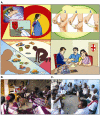Empowering the people: development of an HIV peer education model for low literacy rural communities in India
- PMID: 18423006
- PMCID: PMC2377249
- DOI: 10.1186/1478-4491-6-6
Empowering the people: development of an HIV peer education model for low literacy rural communities in India
Abstract
Background: Despite ample evidence that HIV has entered the general population, most HIV awareness programs in India continue to neglect rural areas. Low HIV awareness and high stigma, fueled by low literacy, seasonal migration, gender inequity, spatial dispersion, and cultural taboos pose extra challenges to implement much-needed HIV education programs in rural areas. This paper describes a peer education model developed to educate and empower low-literacy communities in the rural district of Perambalur (Tamil Nadu, India).
Methods: From January to December 2005, six non-governmental organizations (NGO's) with good community rapport collaborated to build and pilot-test an HIV peer education model for rural communities. The program used participatory methods to train 20 NGO field staff (Outreach Workers), 102 women's self-help group (SHG) leaders, and 52 barbers to become peer educators. Cartoon-based educational materials were developed for low-literacy populations to convey simple, comprehensive messages on HIV transmission, prevention, support and care. In addition, street theatre cultural programs highlighted issues related to HIV and stigma in the community.
Results: The program is estimated to have reached over 30,000 villagers in the district through 2051 interactive HIV awareness programs and one-on-one communication. Outreach workers (OWs) and peer educators distributed approximately 62,000 educational materials and 69,000 condoms, and also referred approximately 2844 people for services including voluntary counselling and testing (VCT), care and support for HIV, and diagnosis and treatment of sexually-transmitted infections (STI). At least 118 individuals were newly diagnosed as persons living with HIV (PLHIV); 129 PLHIV were referred to the Government Hospital for Thoracic Medicine (in Tambaram) for extra medical support. Focus group discussions indicate that the program was well received in the communities, led to improved health awareness, and also provided the peer educators with increased social status.
Conclusion: Using established networks (such as community-based organizations already working on empowerment of women) and training women's SHG leaders and barbers as peer educators is an effective and culturally appropriate way to disseminate comprehensive information on HIV/AIDS to low-literacy communities. Similar models for reaching and empowering vulnerable populations should be expanded to other rural areas.
Figures


Similar articles
-
Training outreach workers for AIDS prevention in rural India: is it sustainable?Health Policy Plan. 2003 Dec;18(4):411-20. doi: 10.1093/heapol/czg049. Health Policy Plan. 2003. PMID: 14654517
-
"Even the fowl has feelings": access to HIV information and services among persons with disabilities in Ghana, Uganda, and Zambia.Disabil Rehabil. 2020 Feb;42(3):335-348. doi: 10.1080/09638288.2018.1498138. Epub 2018 Oct 3. Disabil Rehabil. 2020. PMID: 30282493
-
Evaluation of a targeted AIDS prevention intervention to increase condom use among prostitutes in Ghana.AIDS. 1994 Feb;8(2):239-46. doi: 10.1097/00002030-199402000-00012. AIDS. 1994. PMID: 8043229
-
The human immunodeficiency virus epidemic in India. Current magnitude and future projections.Medicine (Baltimore). 1995 Mar;74(2):97-106. doi: 10.1097/00005792-199503000-00005. Medicine (Baltimore). 1995. PMID: 7891548 Review.
-
Successes, challenges and needs regarding rural health medical education in continental Central America: a literature review and narrative synthesis.Rural Remote Health. 2015 Jul-Sep;15(3):3361. Epub 2015 Sep 25. Rural Remote Health. 2015. PMID: 26402719 Review.
Cited by
-
Testing a peer-based symptom management intervention for women living with HIV/AIDS.AIDS Care. 2010 Sep;22(9):1029-40. doi: 10.1080/09540120903214389. AIDS Care. 2010. PMID: 20146111 Free PMC article. Clinical Trial.
-
The "translators": engaging former drug users as key research staff to design and implement a risk reduction program for rural cocaine users.Subst Use Misuse. 2012 Apr;47(5):547-54. doi: 10.3109/10826084.2011.644379. Subst Use Misuse. 2012. PMID: 22428822 Free PMC article.
-
Challenges experienced by rural women in India living with AIDS and implications for the delivery of HIV/AIDS care.Health Care Women Int. 2011 Apr;32(4):300-13. doi: 10.1080/07399332.2010.536282. Health Care Women Int. 2011. PMID: 21409663 Free PMC article.
-
Implementing and sustaining a mobile medical clinic for prenatal care and sexually transmitted infection prevention in rural Mysore, India.BMC Infect Dis. 2017 Mar 6;17(1):189. doi: 10.1186/s12879-017-2282-3. BMC Infect Dis. 2017. PMID: 28264668 Free PMC article.
-
India-US collaboration to prevent adolescent HIV infection: the feasibility of a family-based HIV-prevention intervention for rural Indian youth.J Int AIDS Soc. 2009 Nov 19;12:35. doi: 10.1186/1758-2652-12-35. J Int AIDS Soc. 2009. PMID: 19925680 Free PMC article.
References
-
- National Family Health Survey (NFHS-3), 2005–2006; report released. 2007. http://www.nfhsindia.org/anfhs3.html
-
- Census of India, 2001 http://www.censusindia.gov.in
LinkOut - more resources
Full Text Sources

